 When it comes to Friday, our thoughts are drawn to life on the sea with the inevitable weekend sojourn to Monte Carlo (doesn’t everyone weekend there?).
When it comes to Friday, our thoughts are drawn to life on the sea with the inevitable weekend sojourn to Monte Carlo (doesn’t everyone weekend there?).
Did you know that Yacht owners can be very snooty about those who own motor launches – floating gin palaces is what they call them. I’ve never figured out if this is a class-thing, or jealousy, but I do know that they are dismissed as flash-Harry’s. Yachties take tremendous pride (probably correctly) in controlling their craft, having invested years to learn the fine art. As far as they see, motor boat owners turn up, turn the key and drive off – far too easy, with not enough suffering.
 The latest innovation from Volvo Penta is bound to add extra ammunition to the yacht-owners dislike of Motor boats and their owners. It looks like it makes it a doodle of maneuver a boat, with almost super-human skills.
The latest innovation from Volvo Penta is bound to add extra ammunition to the yacht-owners dislike of Motor boats and their owners. It looks like it makes it a doodle of maneuver a boat, with almost super-human skills.
They’ve launched the IPS, complete with joystick, designed to ease the handling of motor boats. The Inboard Propulsion System, to give it it’s full moniker, enables the captain to finely control the boats movements by twiddling a joystick.
 They’ve taken the idea beyond simple X-Y joystick movements to incorporate a twisting action and a couple of buttons. X-Y provides the obvious forward/backward, plus an interesting side-to-side action, which doesn’t swing the boat around, but literally slides it sideways – neat.
They’ve taken the idea beyond simple X-Y joystick movements to incorporate a twisting action and a couple of buttons. X-Y provides the obvious forward/backward, plus an interesting side-to-side action, which doesn’t swing the boat around, but literally slides it sideways – neat.
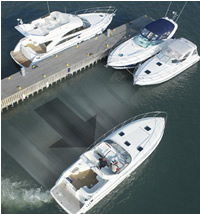 The joystick’s twisting action rotates the boat, seemingly on a six-pence, in either direction, right or left – again, most impressive.
The joystick’s twisting action rotates the boat, seemingly on a six-pence, in either direction, right or left – again, most impressive.
The joystick is only part of it. The rest of IPS secrets are hidden under the boat using what those in the know would call ‘two forward-facing contra-rotating propellers per unit’. To you and me, that’s a couple of engines that you can point in different directions.
With the engines able to act independently, when combined with the joystick, the IPS provides the ability to maneuver with tremendous precision.
We looking forward to getting our hands on it for a full review and are think which of the Digital-Lifestyles boats would benefit from retro-fitting this.
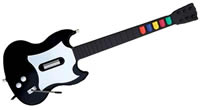 It’s rare that there are inconsistencies in the Digital-Lifestyles clan, but there’s one subject that brings a split consensus. Some of us, me included, think that different forms of controllers for video game is a trend that is just starting – a more natural way of working with the games console is inevitable, like the
It’s rare that there are inconsistencies in the Digital-Lifestyles clan, but there’s one subject that brings a split consensus. Some of us, me included, think that different forms of controllers for video game is a trend that is just starting – a more natural way of working with the games console is inevitable, like the 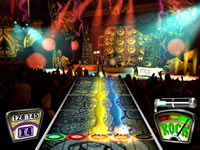 Rock-power-fiends will set their fingers a flyin’ around the five frets, strum-bar and whammy bar. Beyond the buttons, there’s an alignment sensor used to gain extra style points when it’s played vertically. Expect the inducement of dizziness as heads are thrown around in a frenzy.
Rock-power-fiends will set their fingers a flyin’ around the five frets, strum-bar and whammy bar. Beyond the buttons, there’s an alignment sensor used to gain extra style points when it’s played vertically. Expect the inducement of dizziness as heads are thrown around in a frenzy. 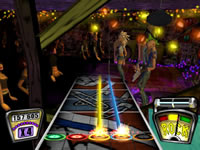 With the Multiplayer mode seeing two players facing-off in what are described as ‘an electrifying series of guitar duels’, it’s quite unclear what will happen over artistic differences, or even usages of the power axe (otherwise known as guitar) as there’s only one shipped with the software.
With the Multiplayer mode seeing two players facing-off in what are described as ‘an electrifying series of guitar duels’, it’s quite unclear what will happen over artistic differences, or even usages of the power axe (otherwise known as guitar) as there’s only one shipped with the software.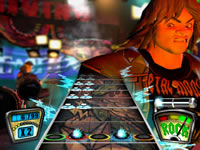 Initial previews have been strong and it’s gained from PR boosts with the like The Darkness talking about on MTV Overdrive. It looks like there’s high hopes from this one.
Initial previews have been strong and it’s gained from PR boosts with the like The Darkness talking about on MTV Overdrive. It looks like there’s high hopes from this one.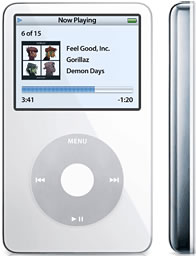 After weeks of frantic speculation that a video-capable iPod was on the way, Apple have sure enough announced the very thing at their event in the California Theatre in San Jose and BBC Television Centre in the UK.
After weeks of frantic speculation that a video-capable iPod was on the way, Apple have sure enough announced the very thing at their event in the California Theatre in San Jose and BBC Television Centre in the UK.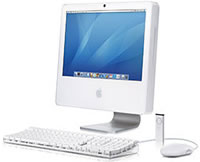 New iMac G5. A bit faster, but the big thing is FrontRow. It’s Apple’s Media Centre-killer. The new Apple Remote, a svelte 6 button remote control that looks like a shuffle, controls any media you have on your iMac. Makes the MS Media Centre 26+ button remote look very wrong – too tech. Simplicity reigns. iSight camera is built in. Parallel output to bigger screen, projector. Price is very tempting starting at $1,299 (17″ £899 inc vat, €1379) (20″ £1199, €1799).
New iMac G5. A bit faster, but the big thing is FrontRow. It’s Apple’s Media Centre-killer. The new Apple Remote, a svelte 6 button remote control that looks like a shuffle, controls any media you have on your iMac. Makes the MS Media Centre 26+ button remote look very wrong – too tech. Simplicity reigns. iSight camera is built in. Parallel output to bigger screen, projector. Price is very tempting starting at $1,299 (17″ £899 inc vat, €1379) (20″ £1199, €1799). Video-capable iPod. Next gen iPod with 30% thinner than current generation player but with a bigger 2.5″ colour screen. 320×240 QVGA (quarter VGA), but not wide screen as rumoured. Video playback supports MPEG-4 and h.264 playback. 30Gb & 60Gb. S-vdeo out through the doc, but video will appear pixelated on full size TV screen. The 30GB should go for $299 (~£219~€349), and the 60GB for $399 (~£300~€469). They’re on the Apple online Store and will be shipping next week.?
Video-capable iPod. Next gen iPod with 30% thinner than current generation player but with a bigger 2.5″ colour screen. 320×240 QVGA (quarter VGA), but not wide screen as rumoured. Video playback supports MPEG-4 and h.264 playback. 30Gb & 60Gb. S-vdeo out through the doc, but video will appear pixelated on full size TV screen. The 30GB should go for $299 (~£219~€349), and the 60GB for $399 (~£300~€469). They’re on the Apple online Store and will be shipping next week.?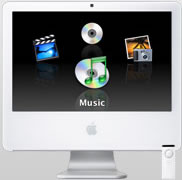 “It’s never been done before, where you could view hit TV shows and buy them online the day after they’re shown,” Jobs said. While this may be true that people have not been able to _Buy_ it, but let’s not forget that the BBC has the iMP trial running, where you can get shows straight after they’re shown – but for nothing.
“It’s never been done before, where you could view hit TV shows and buy them online the day after they’re shown,” Jobs said. While this may be true that people have not been able to _Buy_ it, but let’s not forget that the BBC has the iMP trial running, where you can get shows straight after they’re shown – but for nothing.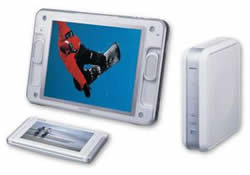 Among the many announcements at CES was an interesting portable 12″ LCD TV screen from Sony, that can be carried around a house and have various content delivered to it from its base station, enabling the showing of video from many different sources, as well as playing music, viewing photos and browsing the Internet. Sony calls it LocationFree™.
Among the many announcements at CES was an interesting portable 12″ LCD TV screen from Sony, that can be carried around a house and have various content delivered to it from its base station, enabling the showing of video from many different sources, as well as playing music, viewing photos and browsing the Internet. Sony calls it LocationFree™.